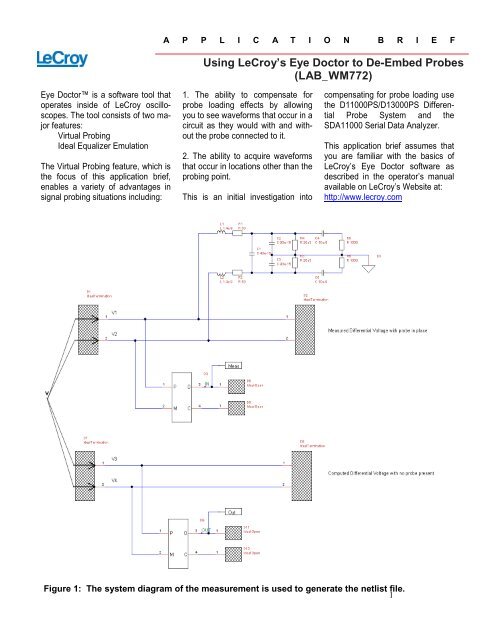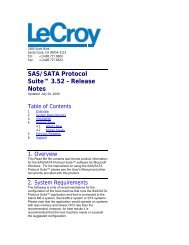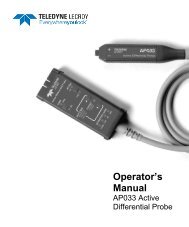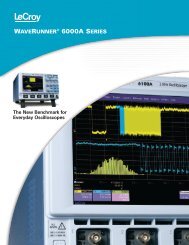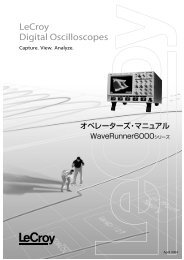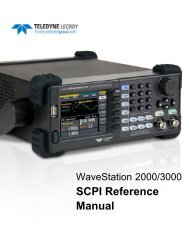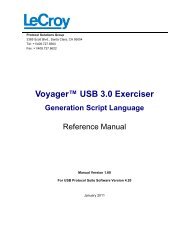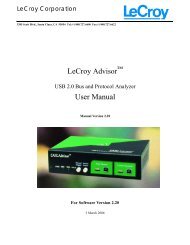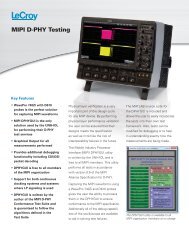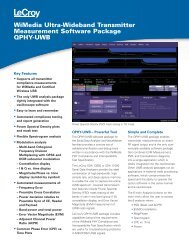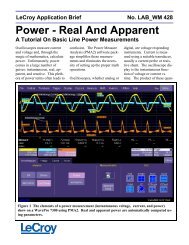Using LeCroy's Eye Doctor to De-Embed Probes - Teledyne LeCroy
Using LeCroy's Eye Doctor to De-Embed Probes - Teledyne LeCroy
Using LeCroy's Eye Doctor to De-Embed Probes - Teledyne LeCroy
You also want an ePaper? Increase the reach of your titles
YUMPU automatically turns print PDFs into web optimized ePapers that Google loves.
A P P L I C A T I O N B R I E F<br />
<strong>Using</strong> <strong>LeCroy</strong>’s <strong>Eye</strong> <strong>Doc<strong>to</strong>r</strong> <strong>to</strong> <strong>De</strong>-<strong>Embed</strong> <strong>Probes</strong><br />
(LAB_WM772)<br />
<strong>Eye</strong> <strong>Doc<strong>to</strong>r</strong> is a software <strong>to</strong>ol that<br />
operates inside of <strong>LeCroy</strong> oscilloscopes.<br />
The <strong>to</strong>ol consists of two major<br />
features:<br />
Virtual Probing<br />
Ideal Equalizer Emulation<br />
The Virtual Probing feature, which is<br />
the focus of this application brief,<br />
enables a variety of advantages in<br />
signal probing situations including:<br />
1. The ability <strong>to</strong> compensate for<br />
probe loading effects by allowing<br />
you <strong>to</strong> see waveforms that occur in a<br />
circuit as they would with and without<br />
the probe connected <strong>to</strong> it.<br />
2. The ability <strong>to</strong> acquire waveforms<br />
that occur in locations other than the<br />
probing point.<br />
This is an initial investigation in<strong>to</strong><br />
compensating for probe loading use<br />
the D11000PS/D13000PS Differential<br />
Probe System and the<br />
SDA11000 Serial Data Analyzer.<br />
This application brief assumes that<br />
you are familiar with the basics of<br />
<strong>LeCroy</strong>’s <strong>Eye</strong> <strong>Doc<strong>to</strong>r</strong> software as<br />
described in the opera<strong>to</strong>r’s manual<br />
available on <strong>LeCroy</strong>’s Website at:<br />
http://www.lecroy.com<br />
Figure 1: The system diagram of the measurement is used <strong>to</strong> generate the netlist file.<br />
1
The schematic used <strong>to</strong> generate the<br />
netlist file is shown in Figure 1. The<br />
upper circuit represents the probe<br />
impedance placed on a perfectly<br />
matched differential pair. The scope<br />
is measuring the differential component<br />
of the signal. The mode conversion<br />
blocks are used <strong>to</strong> provide a<br />
differential signal that represents the<br />
signal measured by the scope.<br />
The lower circuit is simply the same<br />
ideal differential pair of signals with<br />
no probe impedance present. The<br />
filter calculated using this schematic<br />
will transform the signal acquired by<br />
the scope (Meas) <strong>to</strong> that with no<br />
probe (Out).<br />
The resulting netlist is shown as the<br />
text file in Figure 2, with the manually<br />
added stimulation lines shown in<br />
bold.<br />
The netlist shown in this file was<br />
compiled and filter response of the<br />
loading correction filter was plotted,<br />
using a third party math program, as<br />
a check <strong>to</strong> make sure that the results<br />
were as expected. The correction<br />
filter response plot is shown in<br />
Figure 3.<br />
Based on measurement and simulation<br />
of the actual probe tip loading<br />
loss and loss of the loading equivalent<br />
circuit this looks exactly as it<br />
should. This step is not required but<br />
it was included as an assurance<br />
check.<br />
Figure 2: The netlist corresponding <strong>to</strong> the system diagram<br />
in Figure 1<br />
2<br />
Figure 3: Frequency response of the loading correction<br />
filter
At this point the SDA 11000 scope<br />
and D13000PS probe were set up <strong>to</strong><br />
acquire a pseudo-random bit sequnce<br />
(PRBS) test signal. The result<br />
of that signal acquisition is<br />
shown in Figure 4.<br />
Figure 4: The PRBS signal as measured using the D13000PS<br />
probe and SDA11000.<br />
The next step is <strong>to</strong> setup a math<br />
function using the <strong>Eye</strong> <strong>Doc<strong>to</strong>r</strong> Virtual<br />
Probe Math function as shown in<br />
Figure 5. Note that the text file,<br />
“diff_probe_comp_1.txt”, containing<br />
the netlist is entered in<strong>to</strong> the System<br />
<strong>De</strong>scription field. The settings for<br />
the other fields are <strong>to</strong> be found in the<br />
<strong>Eye</strong> <strong>Doc<strong>to</strong>r</strong> opera<strong>to</strong>r’s manual<br />
Figure 5: The setup for the Virtual Probe math function.<br />
3
The output of the Virtual Probe function<br />
shows the waveform as it would<br />
be seen if the probe was not present<br />
<strong>to</strong> load the signal. Figure 6 shows<br />
the acquired trace overlaid by the<br />
output of the virtual probe. Note that<br />
the ‘unloaded’ trace shows slightly<br />
higher peak values immediately after<br />
each state transition. The effects<br />
are minimal because the scope’s 11<br />
GHz bandwidth is less than that of<br />
the probe.<br />
Figure 6: A comparison of the “loaded” (trace Z1) and<br />
“unloaded” (trace Z2) responses of a 13 GHz probe using an 11<br />
GHz Scope<br />
Figure 7 shows a similar measurement<br />
using an 11 GHz, D11000<br />
probe on an SDA13000 which has a<br />
bandwidth of 13 GHz. The probe<br />
loading effects are more pronounced<br />
in this example.<br />
In these examples we have shown<br />
how <strong>LeCroy</strong>’s <strong>Eye</strong> <strong>Doc<strong>to</strong>r</strong> Virtual<br />
Probing feature can be used <strong>to</strong> deembed<br />
probe loading effects from<br />
your measurement data. This capability<br />
greatly enhances the usability<br />
of the scope in signal integrity<br />
measurements by improving accuracy.<br />
Figure 7: A comparison of the “loaded” (trace F1) and<br />
“unloaded” (trace F2) responses of an 11 GHz probe using a 13<br />
GHz Scope<br />
4


